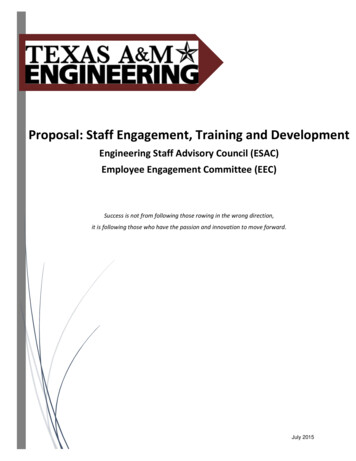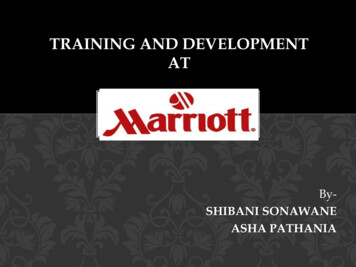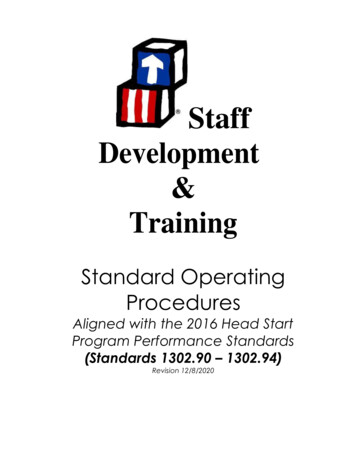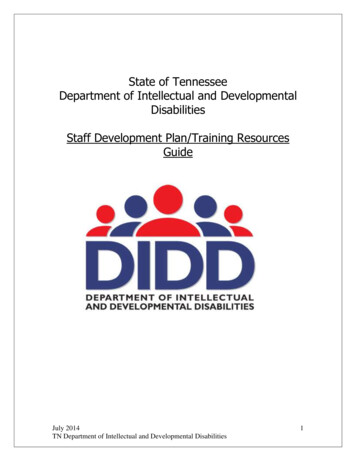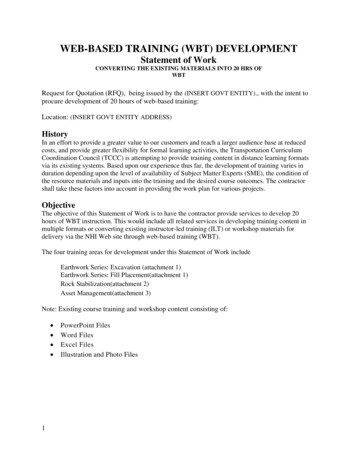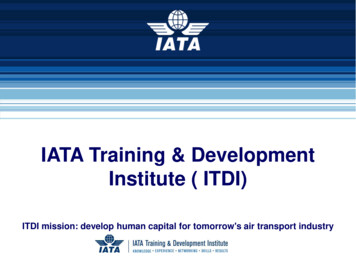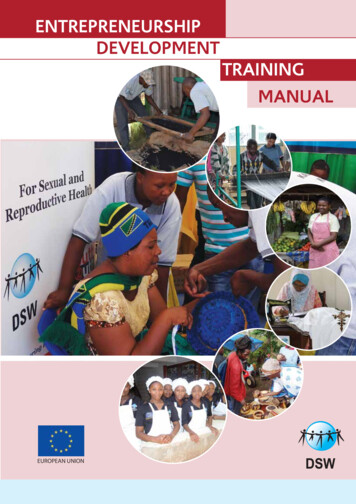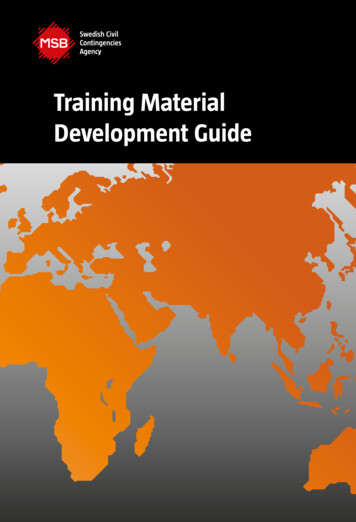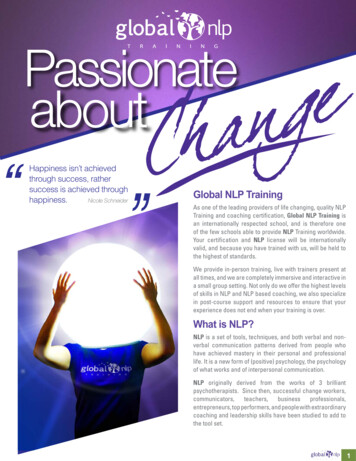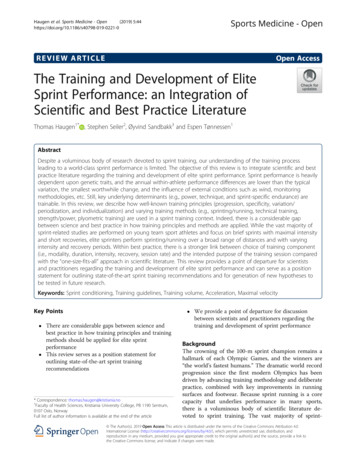
Transcription
Haugen et al. Sports Medicine - Open(2019) W ARTICLEOpen AccessThe Training and Development of EliteSprint Performance: an Integration ofScientific and Best Practice LiteratureThomas Haugen1* , Stephen Seiler2, Øyvind Sandbakk3 and Espen Tønnessen1AbstractDespite a voluminous body of research devoted to sprint training, our understanding of the training processleading to a world-class sprint performance is limited. The objective of this review is to integrate scientific and bestpractice literature regarding the training and development of elite sprint performance. Sprint performance is heavilydependent upon genetic traits, and the annual within-athlete performance differences are lower than the typicalvariation, the smallest worthwhile change, and the influence of external conditions such as wind, monitoringmethodologies, etc. Still, key underlying determinants (e.g., power, technique, and sprint-specific endurance) aretrainable. In this review, we describe how well-known training principles (progression, specificity, variation/periodization, and individualization) and varying training methods (e.g., sprinting/running, technical training,strength/power, plyometric training) are used in a sprint training context. Indeed, there is a considerable gapbetween science and best practice in how training principles and methods are applied. While the vast majority ofsprint-related studies are performed on young team sport athletes and focus on brief sprints with maximal intensityand short recoveries, elite sprinters perform sprinting/running over a broad range of distances and with varyingintensity and recovery periods. Within best practice, there is a stronger link between choice of training component(i.e., modality, duration, intensity, recovery, session rate) and the intended purpose of the training session comparedwith the “one-size-fits-all” approach in scientific literature. This review provides a point of departure for scientistsand practitioners regarding the training and development of elite sprint performance and can serve as a positionstatement for outlining state-of-the-art sprint training recommendations and for generation of new hypotheses tobe tested in future research.Keywords: Sprint conditioning, Training guidelines, Training volume, Acceleration, Maximal velocity We provide a point of departure for discussionKey Points There are considerable gaps between science andbest practice in how training principles and trainingmethods should be applied for elite sprintperformance This review serves as a position statement foroutlining state-of-the-art sprint trainingrecommendations* Correspondence: thomas.haugen@kristiania.no1Faculty of Health Sciences, Kristiania University College, PB 1190 Sentrum,0107 Oslo, NorwayFull list of author information is available at the end of the articlebetween scientists and practitioners regarding thetraining and development of sprint performanceBackgroundThe crowning of the 100-m sprint champion remains ahallmark of each Olympic Games, and the winners are“the world’s fastest humans.” The dramatic world recordprogression since the first modern Olympics has beendriven by advancing training methodology and deliberatepractice, combined with key improvements in runningsurfaces and footwear. Because sprint running is a corecapacity that underlies performance in many sports,there is a voluminous body of scientific literature devoted to sprint training. The vast majority of sprint- The Author(s). 2019 Open Access This article is distributed under the terms of the Creative Commons Attribution 4.0International License (http://creativecommons.org/licenses/by/4.0/), which permits unrestricted use, distribution, andreproduction in any medium, provided you give appropriate credit to the original author(s) and the source, provide a link tothe Creative Commons license, and indicate if changes were made.
Haugen et al. Sports Medicine - Open(2019) 5:44related training interventions have reported positive effects on sprinting capabilities [1–4], leading to the assumption that sprinting performance is easily improvedwith a variety of methods. In contrast, observations ofelite athletes over time show a very different reality, onewhere most annual within-athlete performance differences are lower than typical variation, the smallestworthwhile change, and the influence of external conditions (wind, temperature, altitude, timing methods/procedures, etc.) [5, 6]. Plausible explanations for thismismatch between published science and observed practice are (1) publication bias in favor of positive findingsand (2) subject training status bias, with most experimental data coming from studies of untrained or moderately trained performers.In contrast to the many descriptive studies of worldclass endurance athletes (e.g., [7–9]), no studies ofworld-class sprinters to date have described the varyingtraining components (modality, duration, intensity, resting periods, session rate, etc.) across the annual cycle. Itis fair to say that positive developments in sprint trainingmethods employed by world-class athletes have not beendriven by sports scientists. Publicly available “recipebooks” and training guides based upon the practical experience and intuition of world-leading sprint coaches,and also governing body documents from acknowledgedathletics federations, have become important and popular sources of best practice training information andframework development for the international sprintcommunity [10–18]. We believe combining data sourcesfrom available research evidence and results-provenpractice provides a valid point of departure for outliningstate-of-the-art sprint training recommendations and forgeneration of new hypotheses to be tested in future research. The objective of this review is therefore to integrate scientific and best practice literature regarding thetraining and development of elite sprint performance.Although the present review is anchored in athletics andcompetitive 100-m sprinting, most of the content is alsorelevant for other sports where linear sprints frequentlyoccur.Sprint Performance DeterminantsThe 100-m sprint has traditionally been categorized intothree main phases: acceleration, maximal velocity, anddeceleration [19, 20]. The acceleration phase can in turnbe segregated into initial (start block and reaction), middle, and final subsections [21]. Reaction time in worldclass sprinters is typically 0.17–0.18 0.03 s [22]. Theshape of the velocity curve is consistent across performance level, but the duration and quality of each phasevary from athlete to athlete. Overall, maximal velocity ishighly correlated with 100-m sprint performance, andthe best sprinters accelerate over a longer distance thanPage 2 of 16their lower performing counterparts [23, 24]. Table 1displays an overview of observed split times as a functionof 100-m sprint performance level [25–32] and can beused to identify individual strengths and weaknessesacross the varying phases.Power, technique, and sprint-specific endurance areconsidered key underlying determinants of 100-m sprintperformance [3, 11–16, 24, 33, 34]. A very strong relationship exists between maximal horizontal power output and sprint performance; the shorter the sprintdistance is, the higher the association with maximalhorizontal power output [35]. Power output demand insprinting increases exponentially with velocity [35, 36].Slawinski et al. [23] reported that step averaged maximalhorizontal power output in male and female world-classsprinters was 30.3 2.5 and 24.5 4.2 W kg 1, respectively, typically reached after 1 s of sprinting. The highest individual values for men and women were 36.1 and29.3 W kg 1 respectively, representing current upperlimits in humans [37].Although the basic principles of sprinting are relativelysimple and governed by the laws of motion, the way anathlete solves the mechanical constraints and utilizes thedegrees of freedom within these constraints is far morecomplex [24]. A review of research literature shows thatthe following kinematic variables have received the mostattention [38–47]: Spatiotemporal variables (e.g., step length, step rate,contact time, flight/aerial time) Segment configuration at touchdown and lift-off Lower-limb segment velocities immediately prior totouchdown or during ground contact Front- and back-side mechanicsIndeed, sprint mechanical variables are entangled, andno single variable is associated with better performance[24]. Because kinetics and kinematics are entwined, athletes cannot apply sprinting mechanics that they are notadequately predisposed to. For more information regarding the sprint running technique, we refer to previouslypublished biomechanical analyses (e.g., [20, 24, 33, 34,38–51]).Sprint-specific endurance refers to the decelerationphase of the sprint. The velocity decline is typically accompanied by a reduction in step rate [24]. Sprintrelated fatigue is attributed to disturbances in the centralnervous system and peripheral factors within the skeletalmuscles [52–55]. Available research indicates that legstiffness, which influences elastic energy storage, is particularly crucial for sprint-specific endurance [56–61].Sprint-specific endurance is also determined by instantaneous energy delivery [24]. Estimated from accumulated oxygen deficit measures, the relative anaerobic
Haugen et al. Sports Medicine - Open(2019) 5:44Page 3 of 16Table 1 Split times (mean SD) across 100-m sprint performance leveln30 m (s)60 m (s)80 m (s)30–60 m (s)60–80 m (s)80–100 m (s)60–100 m (s)13.786.317.922.531.611.663.27100 m men9.58a9.71–9.8053.82 0.016.37 0.038.05 0.032.55 0.021.68 0.031.72 0.033.40 0.059.81–9.9073.83 0.046.42 0.048.12 0.022.60 0.021.70 0.031.75 0.023.45 0.059.91–10.00123.85 0.046.46 0.048.18 0.042.61 0.021.73 0.011.77 0.023.50 0.0310.01–10.10213.89 0.046.51 0.038.26 0.032.62 0.031.74 0.011.79 0.023.54 0.0410.11–10.20243.95 0.046.60 0.058.36 0.052.64 0.031.75 0.011.81 0.043.57 0.0310.61–10.7044.07 0.026.89 0.038.76 0.032.82 0.011.87 0.021.90 0.053.78 0.0610.71–10.80124.10 0.036.94 0.048.83 0.032.84 0.011.88 0.021.93 0.033.82 0.0410.81–10.9054.17 0.066.99 0.048.89 0.032.85 0.021.90 0.011.95 0.033.86 0.0410.91–11.0064.17 0.077.05 0.048.97 0.032.87 0.041.92 0.021.99 0.033.92 0.0411.01–11.1064.18 0.057.09 0.039.03 0.022.89 0.041.94 0.022.01 0.023.95 0.0311.11–11.2094.20 0.057.15 0.059.13 0.042.95 0.021.98 0.022.04 0.044.02 0.05100 m womenThe calculations are based on biomechanical reports from international championships [23–30]aUsain Bolt’s world record race from 2009energy system contribution (from stored adenosine triphosphate, stored phosphocreatine, and anaerobic glycolysis) is about 80% for 100-m sprint [62].Sprint performance is heavily dependent upon genetictraits. Charlie Francis, an acknowledged sprint coach,stated that “sprinters are born, not made” [14]. However,which genetic profiles make the greatest contributionhas been the subject for much debate [63, 64], as geneticpredispositions include not only anthropometric characteristics and muscle fiber-type proportions, but also thecapacity to adapt to training [65, 66]. In general, eliteperformance appears polygenetic, with the contributionof numerous genetic variants being additive.Sprint Performance DevelopmentSprint performance capacity evolves and devolvesthroughout life via growth, maturation, training, andaging [5, 67–69]. Age of peak performance in worldclass sprinters is typically 25–26 years [5, 70, 71]. However, the concept of training age needs to be consideredwhen assessing age of peak performance. Athletes whostart with specialized training at a young age may alsotend to reach their peak performance at an earlier agethan their counterparts who specialize somewhat later.Haugen et al. [5] reported that for world top 100sprinters in their early 20s, mean annual improvementswere in the range of only 0.1–0.2%. The very best athletes generally display greater improvement in the yearsjust preceding age of peak performance compared withtheir lower performing counterparts [5, 72, 73]. For example, Haugen et al. [72] reported that the world’s alltime best male and female sprinters improved by anaverage of 8% from 18 years of age, while thecorresponding improvement for Norwegian nationallevel competitive sprinters was 1.3–1.4%. The potentialuse of doping among some of the investigated athletesmay have affected these results, but trainability variations across performance level may also be explained byother factors (e.g., training status, responsiveness totraining, coaching quality, nutrition, etc.). Nevertheless,it becomes very challenging to enhance or even maintainsprint performance beyond the age of 30 [5, 70], mostlikely due to neural and/or hormonal factors and an agerelated decrease in type II fiber distribution and/orcross-sectional area [74–76].Identification and development of sprint talent areconfounded by the observed variation in physical maturation rate and timing. Elite junior athletics is characterized by a combination of marked relative-age effects andhigh attrition rates. Many young athletes may be discouraged from continuing to senior level before realizingtheir full potential [77, 78]. Boccia et al. [79] observedthat, within a group of talented young performers, athletic performance in the early teens is not a good predictor of senior performance in long and high jump. It isreasonable to assume that this is also true for sprinting.Taken all findings together, sprinters who perform at ahigh junior level without excessive specialization are atthe optimal point of departure for senior success. Excessive specialization and inappropriate training progressionincrease the odds of nonfunctional overreaching, overtraini
state-of-the-art sprint training recommendations and for generation of new hypotheses to be tested in future re-search. The objective of this review is therefore to inte-grate scientific and best practice literature regarding the training and development of elite sprint performance. Although the present review is anchored in athletics and
